3. Addressing Global Issues
(1) Environment and Climate Change Issues
The environment emerged as a major topic of discussion in international fora in the 1970s. The importance of meeting environmental challenges has been increasingly recognized through discussions at the United Nations Conference on Environment and Development (UNCED, also called the Earth Summit) in 1992, the World Summit on Sustainable Development (WSSD) in 2002 and the United Nations Conference on Sustainable Development (Rio+20) in June 2012. Rio+20 was followed by a series of discussions on Sustainable Development Goals (SDGs)*. Additionally, environment and climate change issues have been repeatedly taken up as one of the main themes at the G8 and the G20 Summits, where the leaders conducted candid and constructive discussions on these topics. Environmental issues are challenges that the entire international community must address in order to ensure the prosperity of humankind in the future. In order to address global issues and build a sustainable society, UNESCO, as the leading agency, promotes “Education for Sustainable Development (ESD)*.”
< Japan's Efforts >
| Employment

Children and young people in a village in Lombok Island, Indonesia, conducting training of the “Takakura Composting Method” to facilitate environmental conservation. (Photo: Motoko Tatsumi / JICA)
Japan has accumulated an abundance of knowledge, experience and technology concerning environmental pollution control, and has been utilizing them to resolve pollution issues as well as other issues that developing countries face. In particular, Japan implements initiatives to provide support for pollution control measures and for improving the living environment in urban areas, mainly in Asian countries, which are undergoing rapid economic growth. On October 9 to 11, 2013, the Diplomatic Conference for the adoption and signing of the “Minamata Convention on Mercury” was held in Kumamoto City and Minamata City, Kumamoto Prefecture. This convention sets out comprehensive regulations on the whole life cycle of mercury, from production to disposal, in order to reduce the risks of mercury on human health and the environment. Having learned hard lessons from the experience of the Minamata Disease, and being firmly determined that similar health hazards and environmental pollution should never be repeated, Japan proactively participated in the negotiations on the convention and took the role of host country for the Diplomatic Conference. In addition, Japan pledged $2 billion of ODA over three years to support developing countries to address the issues of air pollution, water contamination, and waste management, and also announced the launch of the “MOYAI Initiative” to disseminate information on mercury technologies and environmental restoration from Minamata to the rest of the world.(Note 11)
| Climate Change
Climate change is an urgent issue that requires a cross-border approach. According to the latest Fifth Assessment Report published by the Intergovernmental Panel on Climate Change (IPCC) in October 2014, the global average air temperature increased by 0.85°C from 1880 to 2012. Against this backdrop, the international community, including both developed and developing countries, must strengthen its united efforts to address climate change.
During the 19th session of the Conference of the Parties to the United Nations Framework Convention on Climate Change (COP19) held in Warsaw, Poland in November 2013, all of the Parties were called on to commence the domestic process to prepare their respective Intended Nationally Determined Contributions (INDC) towards the post-2020 framework, and were requested to present the INDC well in advance of COP21 or by the first quarter of 2015 if they were ready to do so. In addition, it was decided to request the Ad Hoc Working Group on the Durban Platform for Enhanced Action (ADP) to identify which information should be provided by Parties when presenting their INDC, and report the result to the COP20. COP19 has contributed to the progress of related discussions, and to the achievement of the goal of completing the preparations for an agreement at COP 21 on a future framework to which all countries present at the conference will become Parties.
Japan also formulated the “Proactive Diplomatic Strategy for Countering Global Warming: Actions for Cool Earth (ACE)*” in November 2013, intending to make a contribution to the world through technology, and is actively implementing countermeasures against global warming. Under this strategy, Japan set the target of halving global greenhouse gas emissions (GHG) by 2050 and cutting the emissions from developed countries by 80% in the same period, and will proactively engage in diplomatic activities to countering global warming by making technological contribution to the world, based on the three pillars of actions, namely “Innovation,” “Application,” and “Partnership.” As a part of this initiative, Japan has been promoting the Joint Crediting Mechanism (JCM)* through which the leading low-carbon technologies of Japan* will be globally used and developed. Complementing the Clean Development Mechanism*, the JCM, as a system, contributes to the reduction of the GHG emissions of partner countries by providing low-carbon technologies and is used to achieve Japan's emission reduction targets. As of the end of FY2013, Japan had signed bilateral documents related to JCM with ten countries (Mongolia, Bangladesh, Ethiopia, Kenya, Maldives, Viet Nam, Laos, Indonesia, Costa Rica, and Palau) and held Joint Committee meetings with Mongolia, Bangladesh, Ethiopia, Kenya, Maldives, Viet Nam, and Indonesia. By the end of FY2013, Japan had conducted a total of 244 feasibility studies and 6 demonstration projects. As part of ACE, Japan mobilized ODA, OOF (Other Official Flows), and private flows for mitigation and adaptation measures(Note 12) in developing countries. In the three years from 2013 to 2015, Japan pledged ¥1.3 trillion (equivalent to $13.0 billion) in official flows and ¥1.6 trillion (equivalent to $16.0 billion) combining public and private flows.
In addition, Japan has been engaged in various kinds of regional cooperation to achieve low-carbon growth at the global level. In May 2013, Japan held the Second East Asia Low Carbon Growth Partnership Dialogue with the representatives of the governments of participating countries and international organizations. The dialogue aimed to promote the establishment of a models for low-carbon growth in the countries and regions represented in the East Asia Summit, which together are the largest GHG emissions area in the world. Active discussions were conducted during the dialogue. These discussions at the dialogue focused on technologies that contribute to low-carbon growth, and the participating countries shared the recognition of the importance of: (i) strengthening cooperation among the governments, local governments and the private sector; (ii) dissemination of appropriate technologies for achieving low-carbon growth; and (iii) importance of full utilization of all available policy tools, including market mechanism. In addition, as for relations with African countries, the “Yokohama Declaration 2013” of TICAD refers to the strategy towards low-carbon growth and climate resilient development, while the Yokohama Action Plan 2013-2017 has set out the provision of assistance as well as the dissemination and promotion of JCM based on this Action Plan.
| Promotion of the Education for Sustainable Development (ESD)
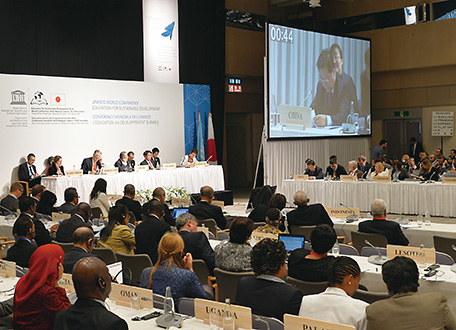
A scene from a ministerial meeting of the UNESCO World Conference on Education for Sustainable Development (ESD) held in Nagoya. (Photo: Ministry of Education, Culture, Sports, Science and Technology)
Education for sustainable development is an important policy area for Japan. In relation to this, Japan hosted the UNESCO World Conference on Education for Sustainable Development (ESD)* in Okayama City, Okayama Prefecture and Nagoya City, Aichi Prefecture in November 2014. 2014 was the last year of the UN Decade of Education for Sustainable Development (DESD), which was originally proposed by Japan. In addition, Japan has been donating funds for the Japanese Funds-In-Trust since 2005, which was the first year of the DESD, and actively promoting ESD through the implementation of projects concerning education about climate change, disaster risk reduction, and biodiversity around the world.
- *Sustainable Development Goals (SDGs)
- SDGs are development goals, which were discussed at the Rio+20 Conference. The launch of the intergovernmental negotiation process to formulate SDGs was agreed on by the conference participants. SDGs apply to all countries, while taking into account the capabilities of each country. This set of development goals is to be incorporated into the post-2015 development agenda of the United Nations. In July 2014, the Open Working Group on SDGs submitted a report.
- *Low-carbon technologies
- Low-carbon technologies are environmentally-friendly technologies with low emission of GHG containing carbon dioxide. Since Japan has superior technologies in this field, it has been working to reduce GHG emissions by making use of these technologies through assistance for high-efficient power plants, sustainable forest management, promotion and development of systems for energy-conservation and renewable energy, and assistance for solid waste management.
- *Proactive Diplomatic Strategy for Countering Global Warming (ACE)
- Following instructions by Prime Minister Abe at the meeting of the Headquarters for Japan's Economic Revitalization in January 2013, Minister for Foreign Affairs Kishida announced the formulation of the “Proactive Diplomatic Strategy for Countering Global Warming - Actions for Cool Earth (ACE)” at a meeting of the Global Warming Prevention Headquarters in November 2013. This strategy consists of three pillars: 1. Development of innovative technologies that will accelerate the efforts to tackle climate change; 2. Overseas application of Japan's technologies; and 3. Financial commitment to provide a total of ¥1.6 trillion (approximately $16.0 billion) of public and private combined flows to developing countries over three years, starting in 2013.
- *Joint Crediting Mechanism (JCM)
- JCM is a mechanism by which Japan's contributions to emission reduction and removal of GHG in developing countries, through the provision of technologies, products, systems, services, infrastructure, etc., leading to the reduction of GHG emissions, are quantitatively evaluated, and the quantitative data are used for achieving Japan's emission reduction target.
- *Clean Development Mechanism
- Clean Development Mechanism is a means for each country to reach its GHG emission reduction targets introduced by the Kyoto Protocol. It is also a system that allows countries to make use of the amount of GHG emission reductions in developing countries to achieve their own emission reduction targets.
- *Education for Sustainable Development (ESD)
- ESD refers to education to nurture leaders of a sustainable society. In this context, “Sustainable development” means the development of a society that meets the needs of the present generation without compromising the ability of the future generation to meet their own needs. This requires each of us to be aware of this concept in our daily lives and economic activities, and to make changes in our respective behavior. Educational activities to achieve such purposes are called “Education for Sustainable Development.”
- Note 11: Financial and technical assistance implemented by the Ministry of the Environment. “Moyai” refers to the “Moyai-Rope,” which is used to tie ships together, and also the “Moyai” collaboration practice in farming communities. “Moyai-naoshi” refers to an initiative to revitalize the Minamata community through dialogue and collaboration.
- Note 12: Mitigation and adaptation measures refer to measures for controlling (mitigating) greenhouse gas emissions, which cause global warming, as well as measures for adjusting (adapting) natural or human systems in response to actual or expected impacts.
| Viet Nam
Project for Capacity Building for National Greenhouse Gas Inventory
Technical Cooperation Project (September 2010 – Ongoing)
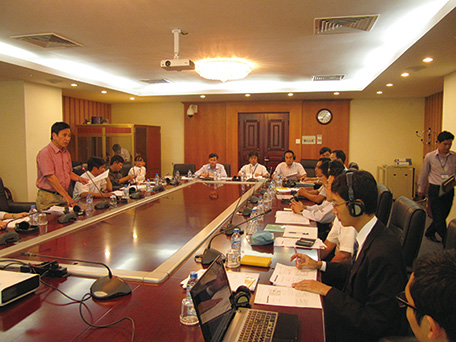
A person in charge on Vietnamese side reporting the progress at a joint coordinating meeting of the project. (Photo: JICA)
The geographical landscape of Viet Nam is characterized by a long coastline that stretches about 3,400 km and vast delta areas1, which make the country one of the most vulnerable countries against climate change in the world.
On the other hand, due to rapid economic growth, energy consumption and greenhouse gas (GHG) emissions in Viet Nam have been increasing. With its GHG emissions increasing at a rate of 11.5% per year, the highest rate among major Asian countries, Viet Nam has been under pressure to implement effective emission reduction measures. Under such circumstances, the Government of Viet Nam announced its initiatives in the reduction of GHG emissions, with the aim to pursue both economic development and environmental conservation, and to develop a low-carbon society2.
In order to formulate a climate change policy, it is necessary to create a “National Greenhouse Gas (GHG) Inventory”3 that provides basic data of the amount of GHG emissions produced during a certain period of time and at a specific location. However, the problem was that no consistent data that could be used for comparison was available in Viet Nam. In order to meet this challenge, this project, conducted by Japan in Viet Nam, aims to provide assistance in building capacity to collect relevant data accurately and continuously as well as manage the collected data adequately. Under this program, Japan has been sending its own experts to Viet Nam to train Vietnamese experts, while also accepting trainees from the country and organizing training programs in Japan. It is expected that these activities will contribute to the formulation of climate change policy in Viet Nam.
It is worth nothing that it was the Ministry of Natural Resources and Environment of Viet Nam that took the lead in producing the National GHG Inventory of Viet Nam in 2010, albeit with the support of the Japanese experts. The document will be included in the first Biannual Updated Report to be submitted to the United Nations Framework Convention on Climate Change (UNFCCC) as early as the end of 2014.
(As of August 2014)
*1 A delta is a geographical feature often seen near the mouth of a river. It is usually a triangular shaped land surrounded by two or more rivers and the sea.
*2 A society that makes efforts to reduce emissions of greenhouse gas such as CO2.
*3 An emissions inventory is a list of the amount of specific substances (such as air pollutants and harmful chemicals) produced during a certain period of time and at a specific location. A GHG inventory is a type of emissions inventory that lists the amount of emissions and absorption of gas, which is considered to be a cause of global warming (greenhouse gas) such as carbon dioxide (CO2), by the emission and absorption source (Reference: Website of the Greenhouse Gas Inventory Office of Japan, http://www-gio.nies.go.jp/faq/ans/outfaq1a-j.html)
| Biodiversity
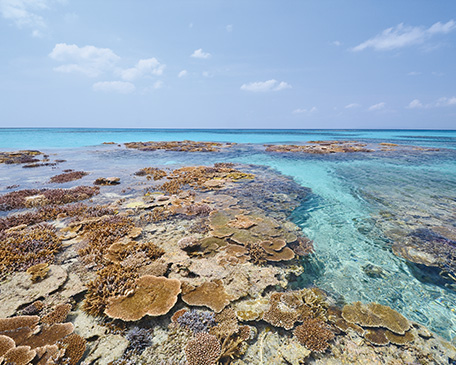
Iriomote Ishigaki National Park (Photo: Ministry of the Environment)
In recent years, the loss of biodiversity, which was caused by the expansion of ranges, scales and types of human activities, has emerged as a serious challenge. Japan, which places importance on biodiversity, hosted the 10th Meeting of the Conference of the Parties to the Convention on Biological Diversity (COP10) in Nagoya City, Aichi Prefecture in October 2010. For example, according to the statistics of OECD-DAC, Japan's international aid in support of biodiversity was over $1.080 billion in 2010 and over $1.476 billion in 2011. These figures make Japan the top donor in the world in biodiversity for two consecutive years. In October 2014, the 12th Meeting of the Conference of the Parties to the Convention on Biological Diversity (COP12) was held in Pyeongchang, the Republic of Korea. A mid-term assessment of the Aichi Biodiversity Targets adopted at COP10 was conducted, and Japan proactively contributed to the discussions in order to maintain the momentum for achieving the Aichi Biodiversity Targets*.
At COP12, it was decided that by 2015, the total international financial flows related to biodiversity for developing countries would be doubled from the average level of 2006-2010, and that this level would be maintained until 2020.
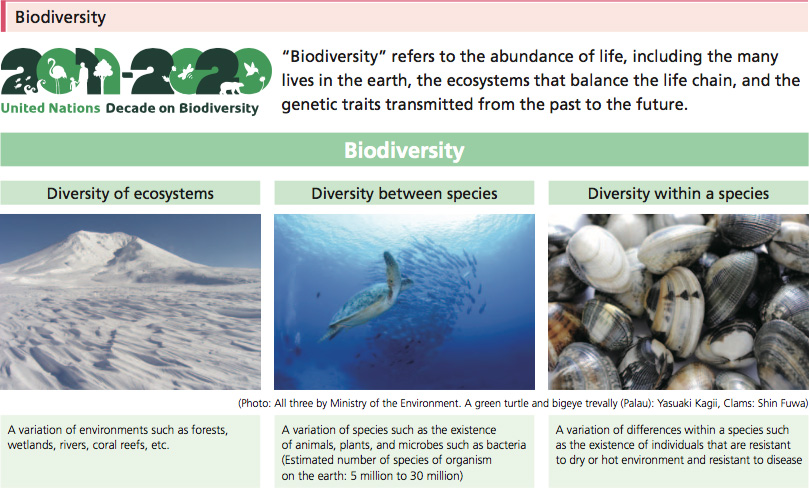
Since living organisms are borderless, the entire world should tackle biodiversity issues; therefore the “Convention on Biological Diversity” was created.
Objectives: Parties to the Convention should work to achieve (i) the conservation of biological diversity, (ii) sustainable use of its components, and (iii) the fair and equitable sharing of the benefits arising out of the utilization of genetic resources.
Developed countries are providing economic and technical supports to developing countries for these objectives.
- *The Strategic Plan for Biodiversity 2011-2020 and the Aichi Biodiversity Targets
- The Targets have set the mid- to long-term goal to achieve “living in harmony with nature” by 2050, with a short-term target of implementing actions to halt the loss of biological diversity by 2020. In addition, 20 individual targets were adopted, including a target of managed conservation areas covering at least 17% of terrestrial areas and 10% of marine areas.
| Nicaragua / Costa Rica
National Program of Sustainable Electrification and Renewable Energy (PNESER Project) (2013 – Ongoing) Guanacaste Geothermal Development Sector Loan (2013 – Ongoing) Loan aid
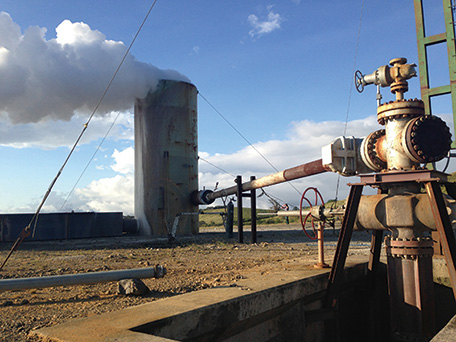
Testing steam discharge for the Guanacaste Geothermal Development Sector Loan - Las Pailas II. (Photo: JICA)
In March 2012, the framework agreement for “Cofinancing for Renewable Energy and Energy Efficiency in Central America and the Caribbean (CORE scheme)” was signed at the annual meeting of the Inter-American Development Bank (IDB) held in Montevideo, Uruguay. This framework is designed to provide ODA loans equivalent of $300 million over five years for eight countries in Central America and the Caribbean, through the cofinancing with IDB.
As the first project of this framework, the Japanese government has launched the “National Program of Sustainable Electrification and Renewable Energy (PNESER Project)” in Nicaragua (an amount up to ¥1.496 billion) co-financed by IDB. Nicaragua is highly dependent on thermal power generation as its power source (approximately 77%), and the electrification rate in rural areas is extremely low, only about 30%. Thus, the diversification of the electric power sources by development of renewable energy, such as the construction of small hydraulic power plants1, and the electrification in the rural areas are the priorities of the power sector. This project is expected to contribute to the solutions for such issues.
“Guanacaste Geothermal Development Sector Loan” for Costa Rica is the second project under the framework of the CORE scheme. In November 2013, the Governments of Japan and Costa Rica signed the Exchange of Notes for ODA loan of up to ¥56.086 billion. Based on this, several geothermal power plants will be constructed in Guanacaste Province in northwest of Costa Rica to increase the amount of electricity supplied by renewable energy. This project aims to mitigate the impacts of climate change, as well as contribute to the sustainable development of Costa Rica.
In order to provide further assistance in addition to the aforementioned projects in Nicaragua and Costa Rica, in March 2014, Japan and IDB signed a memorandum and an implementation agreement of the amendment of CORE scheme at the annual meeting of IDB held in Costa Do Sauipe in Brazil. The new agreement expanded the framework of cofinancing with IDB, increasing the target amount of ODA loans to $1 billion, and the number of recipient countries to 19. With the expended framework, Japan will continue to provide support to increase environment-friendly electric power supply in Central America and the Caribbean.
*1 In general hydroelectric power generation, a dam is built at a location relatively far away from the power station, and electricity is produced by rotating water wheels (turbines) using water pressure and flow of water due to the difference of water levels between the power station and the dam. Although the same principle is used in small-scale hydroelectric power generation (i.e. rotating turbines by using the flow of water), it does not require a large structure like a dam (even if a structure is needed, the scale is small).
(Reference: Web side of the information of small-scale hydroelectric power generation (the Ministry of Environment) http://www.env.go.jp/earth/ondanka/shg/page02.html)
| Côte d'Ivoire
The Project for Rehabilitation and Restoration of Forests with the Involvement of Local Communities
Grant aid (June 2013 – Ongoing)
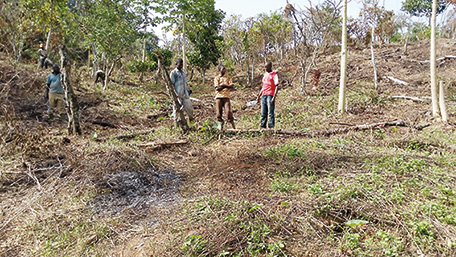
In a degraded forest (site investigation by local residents) (Photo: ITTO)
Forests once covered 60% of Côte d’Ivoire in West Africa. However, the country’s forest area has decreased rapidly over the years due to forest exploitation, excessive commercial logging, and illegal felling. By 2010, the land area of Côte d’Ivoire covered by forests reached a low of 30%. Moreover, as a result of the coup d'état in 2002 and the civil war that followed many internally displaced people entered the country’s forest areas and cut down many trees for fuel use, resulting in further degradation of the forests.
To address this situation, Japan has been working on a project with the aim of regenerating the decimated forests of Côte d'Ivoire in cooperation with the International Tropical Timber Organization (ITTO). The ITTO has long been active in the country. This project employs an agroforestry system, which allows trees and agricultural crops to be cultivated simultaneously. Saplings are planted with potato and other vegetable crops on lands devastated by felling. This method allows local residents to harvest agricultural crops while the trees are being grown, thereby increasing their income level. The project also aims to raise the technical skill level of the residents through the community-based cultivation of saplings and to support capacity building for sustainable forest management.
The project is aimed at restoring and regenerating ruined forests that cover approximately 2,000 ha—roughly one-third the area of Manhattan in New York city in the U.S.A. In addition, it will help support the conservation of another 140,000 ha of forests in the country by preventing further degradation. Furthermore, as the technology and experience in the restoration and regeneration of forests accumulate in the Ministry of Environment, Water and Forests and the Forest Development Corporation of Côte d'Ivoire, it is expected that forest degradation countermeasures and sustainable forest management will be implemented nationwide.
(As of August 2014)
